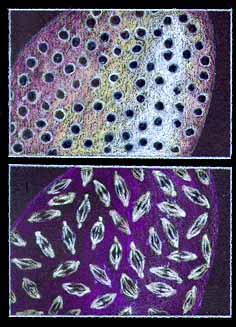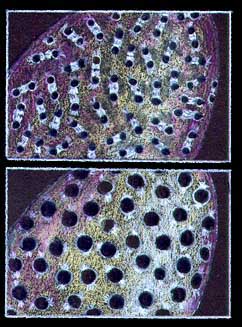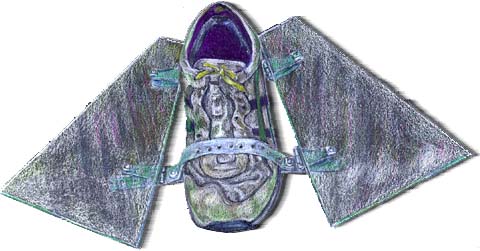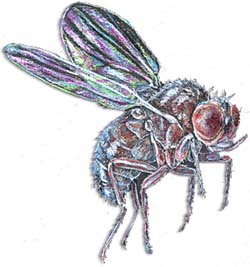THE PROCESS of self-correcting development starts with a tiny fruit fly
egg. After fertilization, the resulting cell duplicates its genetic
blueprint. The two copies separate from each other, and each is sequestered
in its own pouch, or nucleus, inside the cell. This process repeats
as the fly embryo grows, to produce increasing numbers of nuclei.
The nuclei synchronously zip through the first
thirteen reproductive cycles at some of the fastest reproductive rates
known. During this period, the duplicating nuclei inhabit one large
sac. After seven initial divisions in the interior of the embryo,
most of the nuclei begin to migrate to the surface. There they continue
to double in concert, coordinating their movements as well as the
timing of their divisions with choreography that resembles a Busby
Berkeley dance scene in an MGM musical comedy. The appearance of the
embryo reflects this precision: the nuclei that dot the ellipsoid
sac are evenly spaced over the surface. Because so many nuclei are
dividing quickly, simultaneously, and with scripted movements, young
fly embryos lend themselves especially well to the study of regulated
growth.
At the fourteenth division, membranes form to separate
the nuclei into distinct cells. Sullivan is asking some critical questions
about this process. For example, until this point, how do the nuclei
duplicate without bumping into one another? How do the embryos contend
with defective nuclei that arise? These questions snagged Sullivan's
curiosity because the nuclei divide at breakneck speed, closely packed,
with no cell membranes to confine them to their own spaces.
 |
 |
IN MOST mature plants and animals, dividing cells
ensure quality by inspecting their work at every step before they
proceed. This process counteracts the defects that inevitably arise
from slightly imperfect cellular machinery as well as harmful outside
influences, such as environmental toxins. If a cell finds errors,
it pauses to correct them. Cells check, for example, that they've
finished copying their entire genetic blueprint before they split
in two. That way, both offspring cells contain a complete set of plans.
Young embryonic fly nuclei, in contrast, seem more
focused on speed than accuracy. If they fail to copy their genetic
blueprint completely in the time allotted, the nucleus divides anyway,
without a full set of instructions for each resultant nucleus. Delays
in individual nuclear divisions would disrupt the synchrony of the
mass cycling and throw the process into chaos. "It's like in a race
with thousands of people," Sullivan says. "If someone stops to tie
his shoe, it'd be nice if everyone stopped--but that's not what happens."
Like the person with an untied shoe, the disabled nuclei must stumble
along with the crowd.
But animals that accumulate flawed nuclei risk
developmental problems and, after birth, cancer, so scientists reasoned
that there must be some way for the embryo to correct its mistakes.
Leaders in the field suggested that growing fly embryos tolerate imperfections
until division fourteen. At that point, when nuclear duplication slows
down, the embryo begins acting like an adult. Its cells then scrutinize
nuclei and mend injuries, according to the theory.
This idea bothered Sullivan. "They thought there
was no mechanism to deal with damage [early during embryonic growth],
but that didn't make sense," he says. " That's the most important
time in development, so you'd think that it might be important to
do it right."
Sullivan wanted to see for himself what happened
to faulty nuclei in developing embryos. He devised a way to look at
chromosomes within dividing nuclei. Normal chromosomes pair up to
form rows, which facilitate their organization during division. Sullivan
was particularly interested in nuclei with jumbled, instead of neatly
ordered, chromosomes. The nuclei containing these unruly chromosomes
didn't divide properly, and lagged behind their neighbors.
Sullivan saw a ruthless world, where nuclei that
don't keep up get thrown out. Instead of stopping to fix problems,
the embryo tosses defective nuclei into its middle, the "garbage can
of the developing animal," he says, and there they die. "The fly makes
a whole lot of nuclei and just throws out the bad ones," says Sullivan.
In this way, the embryo maintains standards.
A fruit fly embryo can lose as many as half its
nuclei and still turn out right, Sullivan found. "The embryo has a
tremendous ability to compensate," says Sullivan. "You can eliminate
huge numbers of nuclei and somehow the embryo can keep track and replace
what it got rid of."
Beginning at stage fourteen, the animal seems to
value each individual more, and rehabilitates misbehaving cells rather
than sentencing them to death.
Sullivan likens the initial stages of fly development
to a basketball factory. "It's OK if two percent are messed up and
you throw them out," he says. "But if you're making a Mercedes, you
want to make each one perfect. It's too valuable to afford to lose
one." Early on, when the nuclei are interchangeable, they are dispensable.
Later, however, when they commit to futures as wing or antennae components,
their worth increases.
<<
previous || next >>
|




